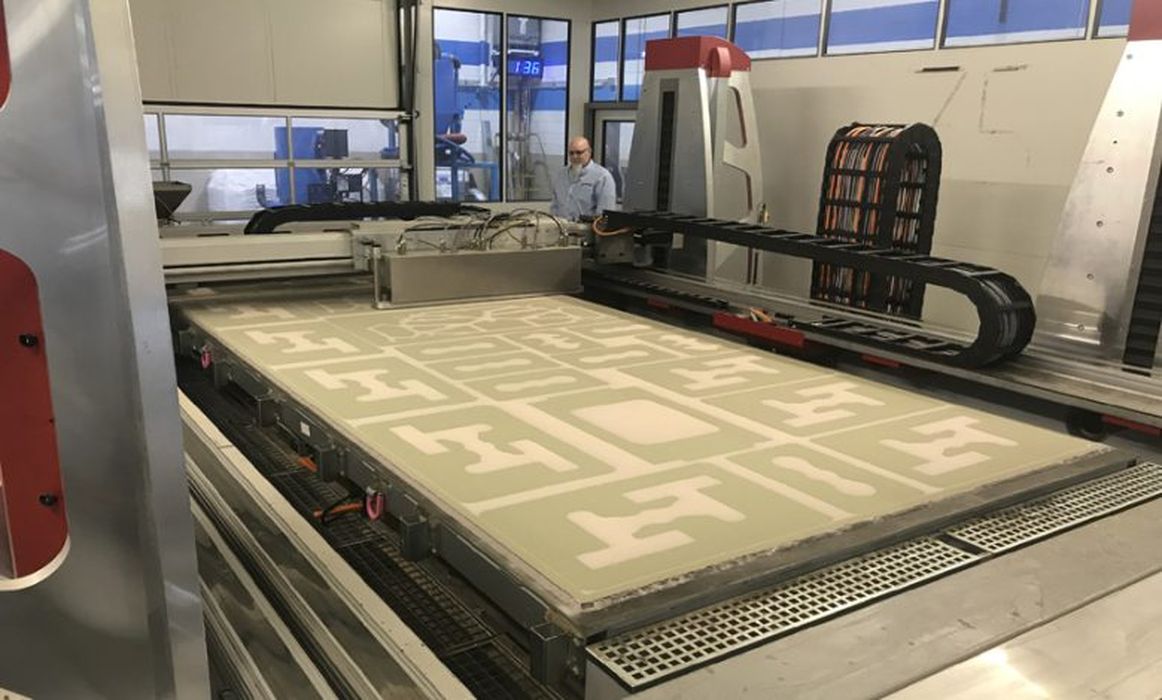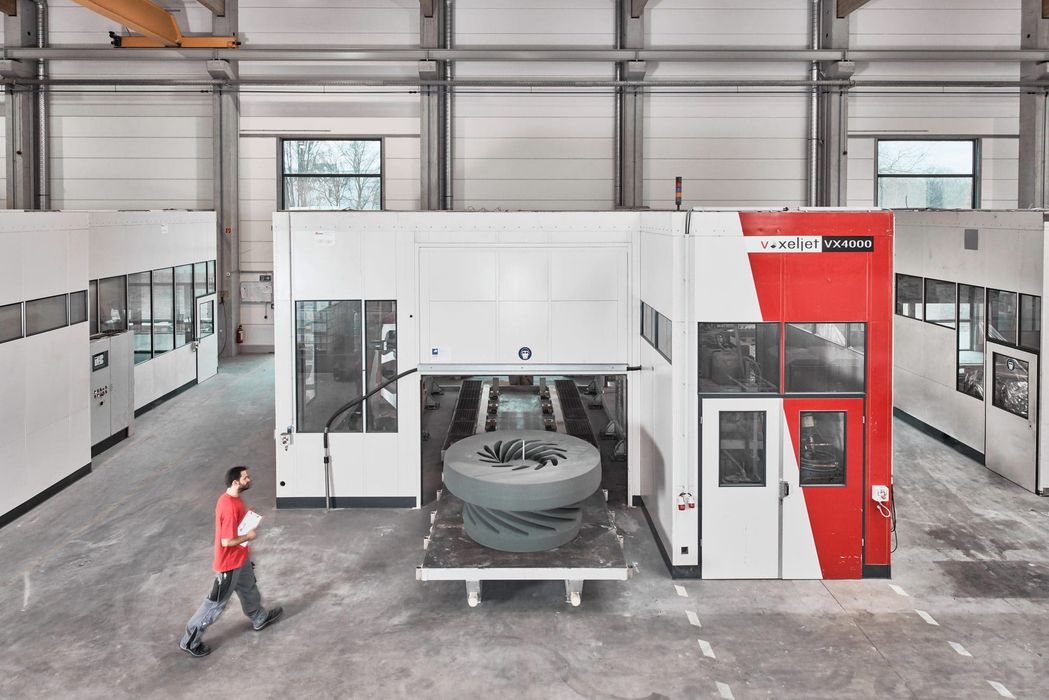
Should binder jetting of sand molds for metal part casting be considered a type of metal 3D printing? And is it taking off?
Should metal casting via binder jetting sand 3D printed molds be considered a metal additive process? Sand binder jetting of molds (or cores) for metal cast parts can be highly automated and does not require a furnace sintering post-process.
In many cases, it requires minimal or no subtractive finishing and no heat treatment. It can be used to produce massively large parts and it is faster than most other metal 3D printing processes. Lately, more and more foundries and even large end-user companies are embracing this technology to produce large and complex metal parts.
While geometry can be limited by the mold, the process still allows for advanced generative designs while using any material currently used for traditional metal casting. Companies like Enable Manufacturing in the UK (with voxeljet technology) and Ventana in France (with ExOne technology) have demonstrated large, highly complex magnesium parts, proving that 3D printing of sand molds can be an ideal intermediate step between existing manufacturing processes and the future of manufacturing. VoxelMatter Research’s recently released market study on the Traditional Ceramic and Sand Additive Manufacturing Market highlights all the players and business opportunities in a market that could be about to boom.
Why shouldn’t metal casting via sand 3D printed molds be considered a metal additive manufacturing process?
While we often would like to think otherwise, 3D printing—especially metal 3D printing—is not a direct, stand-alone manufacturing process. All 3D printing is part of a workflow that includes multiple pre- and post-processing steps. In metal 3D printing, even the most net-shape processes, such as PBF, require multiple post-processing operations ranging from support and powder removal, to heat treatment and polishing. Other processes such as DED are near-net-shape, meaning they require extensive subtractive finishing, while metal binder jetting (and all bound metal processes) require sintering and, in most cases, debinding and infiltrations.
However, even as it continues to gain more and more widespread adoption, binder jetting of sand molds is still a relatively niche area. Today, it is only implemented by a few dozen innovative companies (foundries and sand 3D printing service providers) around the world.
The companies that hold the leadership in the sand binder jetting hardware market, voxeljet and ExOne, are still struggling to emerge as manufacturing powerhouses. They are mostly ignored by financial analysts who do not yet see them as opportunities in their stock portfolios (and rightly so, since their stock value is currently near an all-time low). Yet, they continue to sell machines that can cost well above one million dollars and can generate value for a lot more.
Recently, BMW Group virtually opened the doors of its center in Landshut, Germany to show how it uses both ExOne and voxeljet systems to 3D print sand molds and cores for its metal casting business. Other car companies, including Tesla and General Motors, are looking at and implementing sand binder jetting technology as they shift automotive production towards gigacasting, which is defined as the ability to metal cast entire sections of a car by 3D printing extremely large and complex molds and cores (for die-cast prototyping or end-use parts).
This brings us to another related topic, which is the use of polymer 3D printing to produce sacrificial cores. Printing sacrificial cores for metal casting is possible via stereolithographic 3D printers (in fact this is a major application area for large SLA systems or voxeljet’s unique PMMA binder jetting systems), however, in our analysis, we tend to consider these as polymer 3D printing processes and we will address them only marginally in this article. This remains a relevant topic and a valuable application of 3D printing across multiple industries (automotive, energy, aerospace, maritime), especially considering that it is a process capable of large-batch and serial manufacturing.
In the following sections, we will focus primarily on understanding the value proposition of direct sand binder jetting for the casting of metal parts and what it means for the companies that are making it happen.
What happened to voxeljet?

With its stock priced at just over $1 (from an all-time high above $40), voxeljet has been struggling on the US stock market for most of the past decade. These challenges only partially describe the company’s actual business: although voxeljet has not been recording exponential revenue growth, it has gone from being an innovative tech startup to a global company. The company continues to innovate manufacturing both through its own service centers and with its machines installed in foundries around the world. To better understand voxeljet’s trajectory, we spoke with James O’Neil, the fourth-generation owner of O. K. Foundry Co., who has been closely following the company’s evolution in both the real economy and the financial world.
“We started experimenting and using 3D printed sand molds nearly the same year they became available from ExOne (ProMetal), around 2005,” he tells VoxelMatters. “ExOne opened a service center in Detroit or Houston and I was able to get the ballpark pricing information that a mold would be $0.15 per cubic inch, which enabled me to price projects efficiently for feasibility and even sales. This happened not too long after Hoosier Pattern Industries bought their first S-Max printer. To me, this was a milestone, since I viewed ExOne as an equipment supplier, not a mold supplier, and having third-party service centers, like Hoosier, TEI and Humtown, represented a major evolution of the supplier market. We’ve purchased sand molds from Hoosier ever since, they are a superlative supplier of everything foundry pattern related, including 3D printed sand molds.”
As a stockholder, Mr. O’Neil has been tracking everything that happened with voxeljet since the company went public. “I think voxeljet made significant CAPEX investments into R&D, infrastructure and business development every year,” he says, “[the company] has executed flawlessly on reaching the objectives and milestones of the decade-long R&D investments. They now have substantial sales and manufacturing presence in three global regions, IP and products, and operational capabilities.” James also believes that “the IPO in 2013 was brilliantly timed to capitalize at the peak of the 3D printing investment bubble. The $10 million raise in 2021 was not nearly as rich, but still very well timed to coincide with a stock market rally in 3D printing stocks. Another $4.4 million raise in 2022 at $3.44 per share was timed to cure a problem with working capital instead of exploiting a rallying appetite in markets. It was not a good deal for shareholders except as a way to stave off a cash crisis,” he argues.
This brings us to the latest capital raise with Anzu Partners in December 2022, which only netted $.8 million for voxeljet in exchange for 10% voting rights. O’Neil thinks that this capital raise was an agreement with Anzu Partners to find a buyer for Voxeljet or more private equity. Recently voxeljet initiated a formal review process to “evaluate strategic alternatives”, which includes merging or selling the company but also possibly acquiring another company to strengthen its position on the global market.
Read the rest of this story at VoxelMatters
